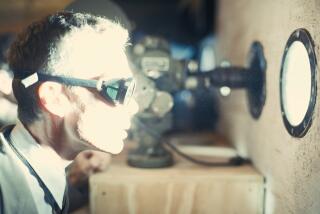MOVIE REVIEW : âHALF LIFEâ AND A LEGACY OF DEATH
If you learn anything from watching âHalf Lifeâ (Sunday at the Nuart), a disturbing new documentary by Australian film maker Dennis OâRourke, itâs that Americans know how to put a positive spin on the most explosive events.
In 1946, a newsreel announcer explained how residents of the tiny Bikini Atoll in the Marshall Islands were âwell pleasedâ that U.S. Army officials were going to âadd a little variety to their lives.â
That was a nice way of saying that the islanders were being evacuated so the Atomic Energy Commission could spend the next decade testing 66 nuclear bombs in their backyard. In 1954, the United States exploded a far more powerful H-bomb near the neighboring islands of Rongelap and Utirik. This time the inhabitants werenât evacuated or told about the tests.
The radiation was supposed to waft in another direction, but the winds shifted. After the blast, the islands were drenched in powdery, white fallout. Children who played in the âsnowâ fell violently ill. The fish tasted bitter. Coconut milk turned sour. Though government records show military ships were nearby, it was two days before anyone was rescued from the fallout-ravaged islands. Could this disaster have been averted? Or did the U.S government deliberately expose the islanders to intense radiation, perhaps as part of a plan to supply longterm data on the effects of nuclear contamination?
Based on the material presented in âHalf Life,â which offers interviews with islanders and American technicians who witnessed the blast as well as recently declassified Defense Department footage, itâs hard to argue with a U.S. radio operator then stationed on the islands. He believes the natives were used as âguinea pigsâ because they lived in a âcontrolled environmentâ perfectly suited for studies of radiation poisoning. Or as an island woman puts it: âI used to think the Americans were smart, but now I think theyâre crazy. . . . Theyâre smart at doing stupid things.â
OâRourke makes no attempt to balance the islanderâs testimony with any official government response. (For the record, a spokeswoman for the Defense Nuclear Agency described the film as âinteresting and informative,â but âstrongly disagreedâ with the implication that âgovernment officials intended to engage in human experimentationâ).
However, OâRourkeâs footage is damning enough. When a Navy officer, long after the tests, sweeps the beaches of the still-inhabited islands, his Geiger counter noisily clicks away like a jackhammer on a city street. We also view a â50s-era Atomic Energy Commission documentary about follow-up radiation tests in America that refers to the islanders as âsavages visiting the white manâs country.â
A shrewd, sympathetic observer, OâRourke shows us post-card-pretty glimpses of the islandsâ tropical vistas, then swoops in for a closer, more chilling look. We see elderly survivors and children, but after a while, you canât help but wonder what happened to the generation in between. As the island oldsters leaf through their photo albums, you begin to suspect the worst--we first see pictures of stunted babies, then tiny children without hair or limbs and finally, shots of kids lying in open, flower-covered coffins.
Many victims are suing U.S agencies for wrongful death and destructive contamination of their property. But the islanders here display more resignation than anger. One gray-haired, toothless woman gives an account--in flat, emotionless tones--of a pregnancy that began after she returned from the initial H-bomb test: âI gave birth to something I cannot describe. It did not look human. I donât know how to say it . . . like the innards of a beast. It was dead at birth.â
The film ends with a clip of a congratulatory message from President Reagan, taped on the eve of the islandersâ independence. Taking note of the islandsâ âspecial relationshipâ with America, he says, âYouâll always be family to us.â Coming after what weâve seen, the statement seems bitterly ironic. You may have seen fanciful TV dramas about the aftermath of a nuclear holocaust. But âHalf Lifeâ (Times-rated: Mature) isnât just a grim, heartbreaking portrait of real-life suffering. Itâs a tragedy. And more important, itâs an American tragedy.
âHALF LIFEâ An OâRourke & Associates Filmmakers production. Producer-Director-Writer-Camera Dennis OâRourke. Music Bob Brozman. Archival Film Research David Thaxton & Kevin Green.
Running time: 1 hour, 26 minutes.
Times-rated: Mature.
More to Read
Only good movies
Get the Indie Focus newsletter, Mark Olsen's weekly guide to the world of cinema.
You may occasionally receive promotional content from the Los Angeles Times.










